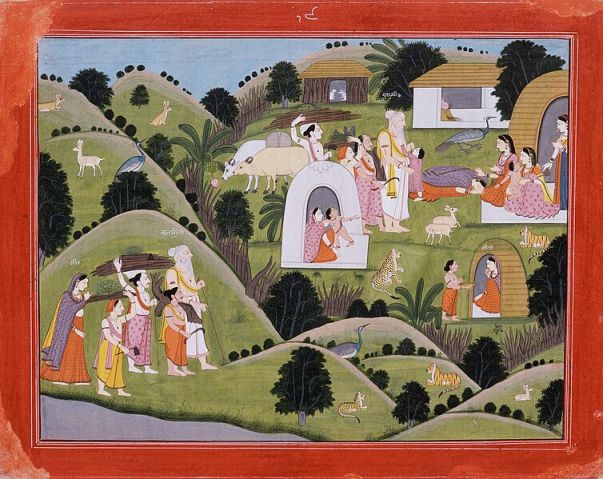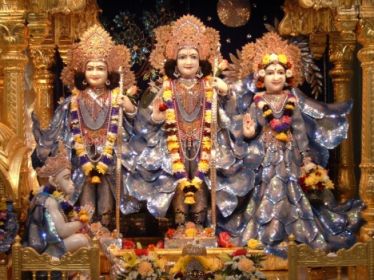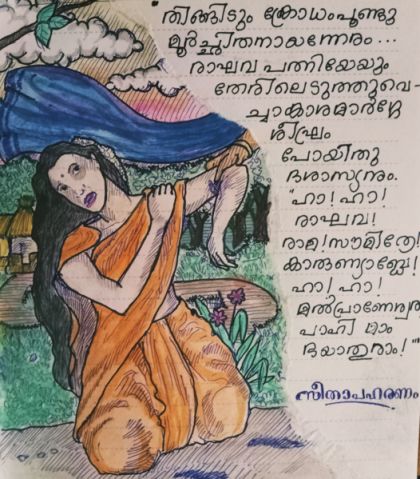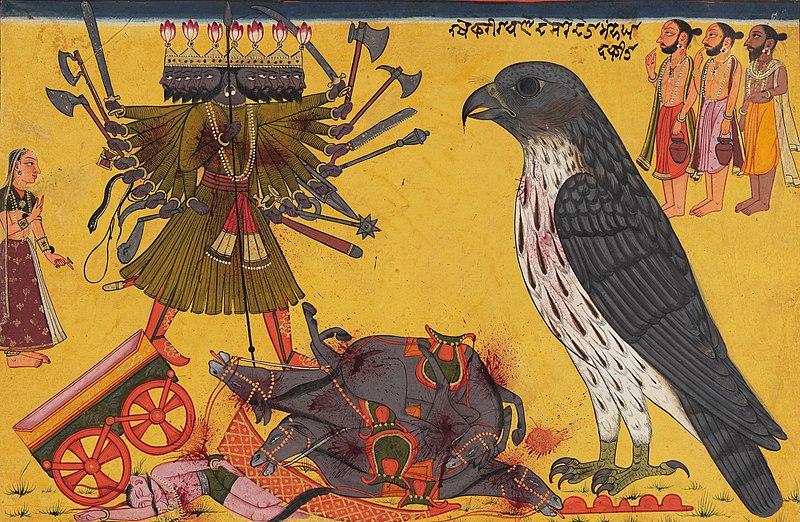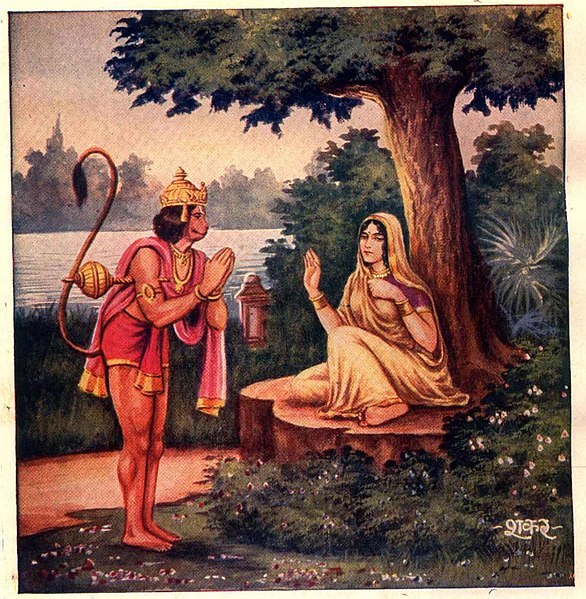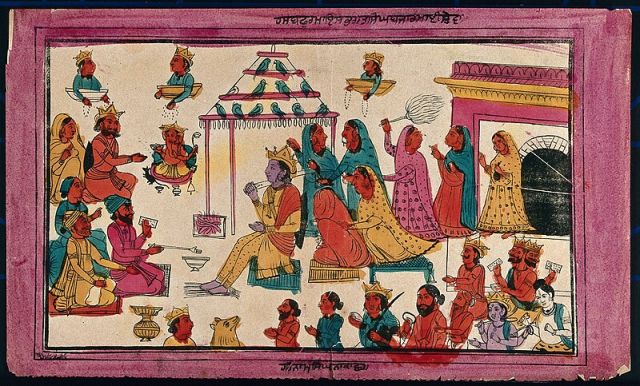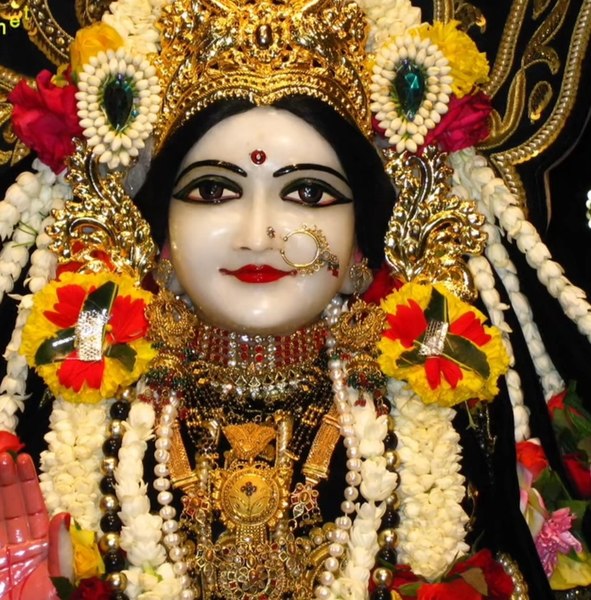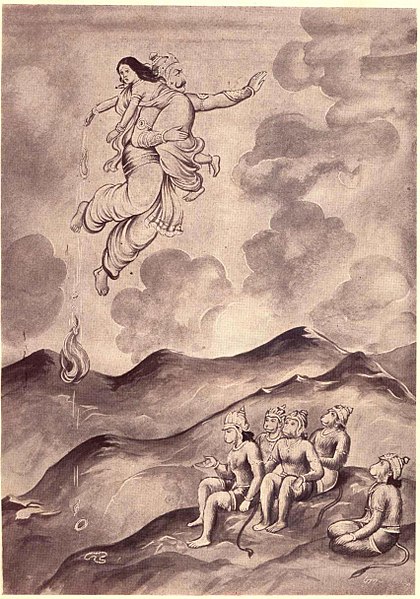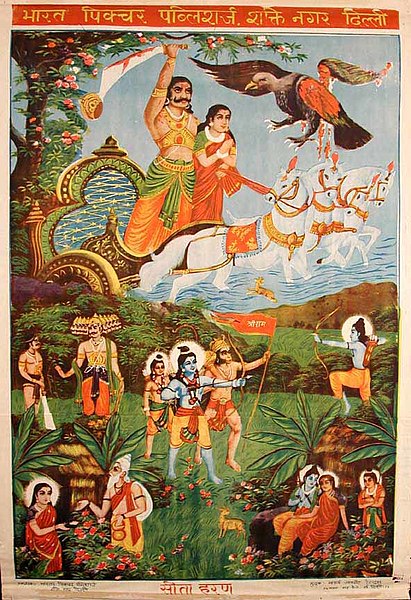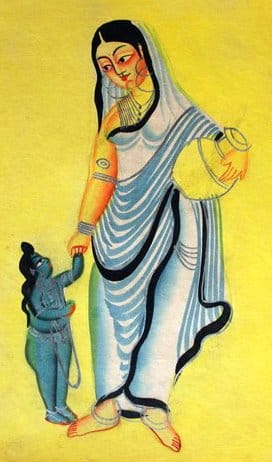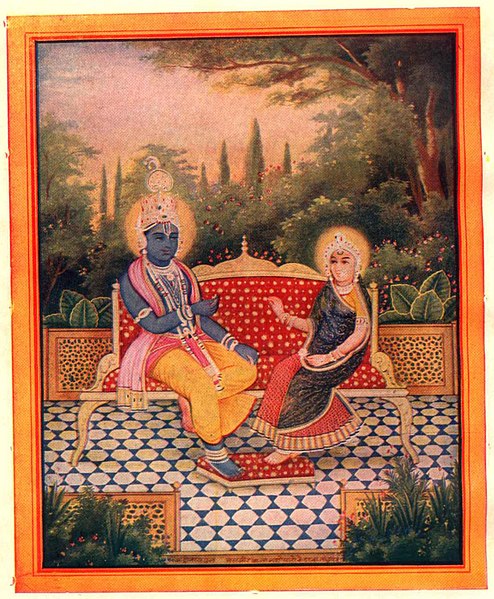The concept of incarnation is central to Hinduism. In the multidimensional pantheon of Hindu Goddesses, one Goddess often has different incarnations in different yugas( epochs ) of time. The Goddess is born in human form at a definite time to fulfill a definite purpose. When that purpose is fulfilled, she returns to her heavenly abode.
Sita Mata, a revered Devi in the pantheon of Hindu Goddesses is the wife of lord Ram who was born as the avatar of Vishnu in Treta Yug. Devi Sita, his wife and consort is thus the incarnation of Devi Lakshmi, the wife of lord Vishnu. Sita Mata is the Goddess of purity, devotion, virtue, loyalty, courage, dedication, tenderness, and sacrifice. She embodies all the qualities of an ideal woman. That’s why in India, whenever a child is born, parents desire him to be an image of lord Ram, if it’s a boy and Sita Mata if it’s a girl. Just as lord Ram is considered the embodiment of the ideal man according to Hindu Dharma, Sita Mata is considered the paragon of the ideal woman.
From my own experience I have seen how Hindus in India congratulate a newly wed couple by saying, “ Ram Sita kee jodi hai ” ( it’s like the pair of Mata Sita and lord Ram ). This is a way of blessing the couple and telling them that their relationship should be based on similar values of love, devotion, purity, and sacrifice as the relation of lord Ram and Mata Sita.
The Ramayana – Rama’s Journey
We get to know about the story of Sita Mata through the Hindu epic Ramayana. Her life story is an unusual one that’s full of tales of womanly courage and sacrifice. Mata Sita’s life trajectory is also open to multiple interpretations. That is why Devi Sita’s story has had multiple retellings and reinterpretations in literature and culture.
Many people associate Devi Sita with the conventional characteristics of a woman. But several cultural and literary interpretations cast Sita Mata in a feminist mold, examining her life choices and trajectory from a feminine perspective.
For Hindus, Sita is a revered deity who is often worshipped alongside her husband, lord Ram. Whenever lord Ram’s name is taken, Sita Mata’s name automatically comes along with it, as is evident from the popular expression in India, Jai Siya Ram ( Siya is a synonym for Sita Mata, so Jai Siya Ram means hail lord Ram and Mata Sita). The expression Jai Siya Ram has often been used in the Indian countryside as a form of greeting; such is the devotion and love for lord Ram and Devi Sita in the soil of India.
Sita Mata in the Pantheon of Hindu Goddesses
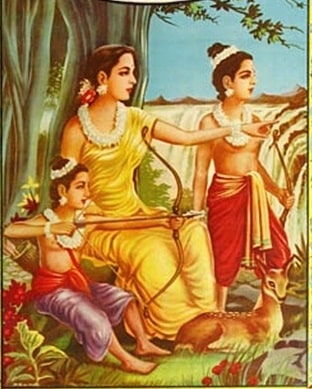
Devi Sita is considered the incarnation of Goddess Lakshmi as the consort of Sri Ram in Treta Yuga who is the incarnation of lord Vishnu.
The Vedas mention various other incarnations of Sita Mata as well. According to one story, she is Vedavati, a female ascetic and devotee of lord Vishnu who entered the blazing fire when Ravana tried to molest her.
According to the Kaushik Sutra of Atharva Veda, Mata Sita is the wife of Parjanya ( lord Indra who is the God associated with Rain). In Shukla Yajur Veda as well, there is a mention of Mata Sita being the wife of lord Indra.
Mata Sita is also worshipped as an earth Goddess, since she emerged from the earth. Some communities also worship her as an agricultural and fertility deity, and pray to her for a bountiful crop.
Devi Sita is revered not just in India but also in several countries of south-east Asia. She is also a highly worshipped deity in Nepal as her birth place is believed to be Janakpur, that is located in present day Nepal.
Overall, we can say that Devi Sita is an extremely important Hindu Goddess who is revered and worshipped throughout India. Also, since Sita lived in the Treta Yug in human form as an avatar ( incarnation), people find it easier to relate to Goddess Sita. Devi Sita as the wife of King of Ayodhya lord Rama is somewhat closer to our lives as Hindus as we can see many of the complexities and struggles of our own existence being mirrored in the life story of Prabhu (God ) Shri Ram and Mata Sita.
Devi Sita in the Context of Hindu Epic Ramayana
We get to know the life story of Devi Sita and lord Ram primarily through the Hindu epic of Ramayana. Ramayana is one of the greatest Hindu epics of all times and dates back to thousands of years.
There are two popular versions of Ramayana in India. One is Valimiki’s Ramayana and the other is Ramcharitmanas written by Goswami Tulsidas Valmiki’s Ramayana has 24,000 Shlokas, 500 upkhand and 7 kandaas. Tulsidas’s Ramcharitmanas has 7 kandas, 9 shlokas, 688 dohas, 55 sortas, 118 chhand and 1060 chhaupai.
The word Ramayana literally translates into “Ram’s journey”. The epic tells the story of Prabhu Shri Ram, Mata Sita and Laxman ( the brother of lord Ram ). We will get to know about Devi Sita’s story as told in Ramayana in subsequent sections. But overall speaking, the epic Ramayana teaches us a lot of things about human behavior, and the complexities of the human psyche. Most importantly, through the life-stories of Devi Sita and lord Rama, the epic teaches us the importance of making right choices when we are faced with tough decisions. In other words, it teaches us to live our life according to Dharma ( the ethics of living and acting righteously ).
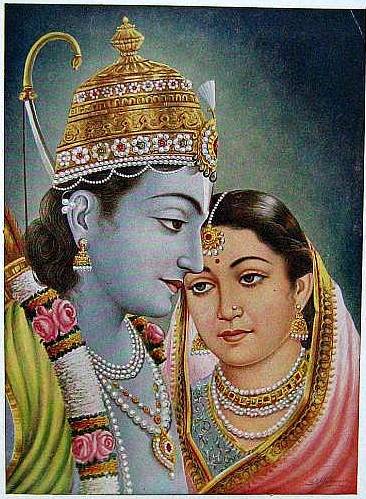
Wife to Lord Ram
Devi Sita as the wife of lord Ram is the central character of Ramayana. She emerges as a strong and willed character as she voluntarily chooses to live with her husband in the forests for a period of 14 years as Rama faces exile. As Sita is abducted by Lanka king Ravana, she stil doesn’t lose her calm and keeps up her faith in the love of Prabhu Shri Ram whom she is sure will move mountains to rescue her from the clutches of evil.
Mata Sita’s life doesn’t get any easy even after getting freed from Ravana’s Lanka and getting united with lord Ram. She has to repeatedly prove her purity in front of the world and this leads to her making some tough life choices.
Devi Sita emerges as a strong female character in Ramayana
Overall, Devi Sita is the paragon of beauty, purity, virtue, devotion, sacrifice, determination, resolve, and also a great deal of detachment, as portrayed in Ramayana. She embodies the complex manifestations of womanhood. Many people commit the mistake of reducing Mata Sita’s character to that of a meek and subservient wife. But that is far from the truth.
An ideal woman according to the ideals of Hindu Dharma isn’t the one who is meek and subservient. I can say this from my own experience. Women in Hindu society might be expected to perform certain conventional roles but they also wield a lot of power and have an equal say in decision making.
As a wife, it’s the woman who keeps the house together and enjoys more power than men of the household when it comes to decisions affecting her home. Similarly, Devi Sita is portrayed as a dynamic female character in Ramayana who is at equal ease living in the forest, and doesn’t even shy away from living again in the forest alone bringing up her children all by herself.
Sita’s role in the Ramayana is pivotal. As the consort of Lord Rama, she is central to the epic’s narrative, her journey mirroring the trials and triumphs of dharma (righteousness). Her character embodies the ideals of womanhood and wifehood in Hindu culture, setting a paradigm of virtue. Sita’s experiences, from her blissful life in Ayodhya to her abduction by Ravana and subsequent trials, outline a narrative rich in spiritual and moral lessons.
The Symbolic Significance of Sita Mata
At a symbolic level, Devi Sita is the one who is always connected with lord Ram. Sita and Ram are inseparable. That’s why Jai Siya Ram ( hail Mata Sita and lord Ram ) is often used as a greeting in India. Sometimes, the name of Devi Sita is taken before lord Ram as evident in the popular phrase “Siyavar Ramchandra kee Jai” ( hail the consort of Maa Sita – Shri Ramchandra ).
Even though Devi Sita is widely celebrated as a human incarnation in the form of lord Ram’s consort in Treta Yug, trying to understand them merely through human terms vastly limits the field of understanding and comprehension. When one looks at Devi Sita and lord Ram symbolically, they are not separate individuals. Sita and Ram’s existence reflects the duality of Shiva and Shakti. Devi Sita is intrinsically connected to lord Ram and together, their energies hold the entire fabric of existence.
The Strong Connection to Nature
Since Devi Sita is born of a furrow in the ground, she also represents one’s connection and bonding with nature. That’s why she is revered as an earth Goddess. Devi Sita’s story of springing from the earth and then voluntarily submerging her existence into the womb of that same earth represents the cosmic reality of human beings. We are all intrinsically connected to the soil and it is in soil that we eventually get merged as we leave our mortal bodies. Thus, Sita Mata’s story is also the story of material detachment. Born to a life of riches and married to a prince, her usual life-trajectory would have been that of a queen. But she chooses the tough way out, accompanying her husband to forest exile, something that changes her entire life trajectory.
Thus, Sita Mata also represents nature in its feminine form. Devi Sita’s longing for pristine forest life represents the urge of primeval feminine energy that is Shakti to experience the pure,unadulterated and free-spirited life of the forest. Her second exile into the forest during which she brings up her sons Luv and Kush all by herself in the ashram of sage Valmiki.
Sita Mata, in the grand tapestry of Hindu mythology, symbolizes the virtues of patience, loyalty, and moral integrity. Her life is a testament to the strength of character, as she faces trials and tribulations with grace and unwavering faith. Her ordeal in the Ashoka grove and the fiery trial of Agni Pariksha (trial by fire) are emblematic of her purity and commitment to dharma, serving as profound symbols of personal resilience and spiritual strength.
Representation in Art and Scripture
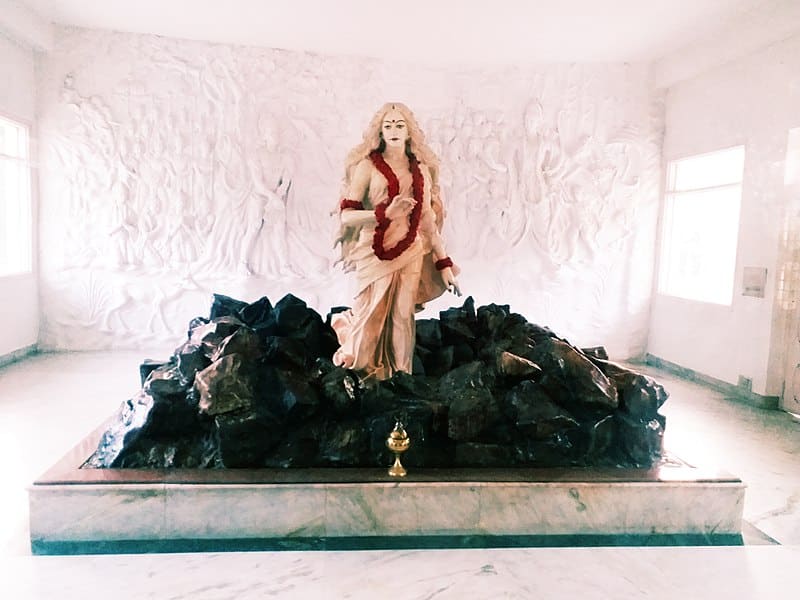
In art and scripture, Devi Sita is often depicted with an aura of serene dignity. Often in the company of Lord Rama or in scenes from the Ramayana that highlight key moments in her life.
These depictions are not mere artistic renderings but are imbued with deep symbolic meanings. They serve as visual narratives that capture the essence of her virtues and the trials she endured, offering a window into her profound spiritual stature.
Devi Sita is often depicted in various traditional folk art forms of India like the Madhubani art form that originated in the Indian state of Bihar. These colorful paintings often depict scenes from Ramayana and Devi Sita during different episodes of her life. Scenes from Ramayana are also depicted in various other folk art forms of India like Tikuli, Kalamkari, and Kalighat.
Being an Indian and Hindu, I can say that Devi Sita is an integral part of the traditional art and culture of India. Many folk songs of India are based on the life events of Mata Sita and lord Ram. Many of these songs are sung and performed on weddings and other auspicious occasions even today.
Devi Sita is a living Goddess who is imbued in the cultural fabric of India. People of this land have a deep emotional connection with Mata Sita. That’s why Devi Sita has inspired so many art forms in India from traditional to modern and contemporary art. Together it gives a range of exciting and new interpretations to the essence of Devi Sita.
Sita Mata Origins
We have already mentioned in the previous sections that Devi Sita is an incarnation of Hindu Goddess Lakshmi. The story of her birth is rather unusual.
According to Ramayana, King Janaka, ruler of the kingdom of Mithila had remained childless for long so he was sad also he was a wise man and of a saintly disposition. Around the same time, Asuras, that is demons, were wreaking havoc on earth.
Thus, Bhumi Devi, the earth-Goddess requested lord Vishnu to incarnate her in this world and help her out. To this lord Vishnu replied that he will incarnate as Ram, his next avatar on earth and Devi Lakshmi will incarnate within Bhumi Devi. That, Devi Lakshmi and Bhumi-Devi will take a human form collectively. This is how Sita Mata was born out of a furrow since Bhumi Devi represented Mother earth.
Thus, literally speaking, Mother Earth had given birth to Mata Sita. She appeared miraculously in a furrow as king Janak was ploughing the field as a part of a Vedic ritual in the kingdom of Videhas ( also known as Mithila), an ancient Indian kingdom in late Vedic India.
Thus, king Janaka adopted the child and named her Sita, that is one who is born out of a track. Janakpur located in present day Nepal is widely regarded as Mata Sita’s birthplace.
Devi Sita was born in Navami, on the 9th lunar day, in the month of Vaishakha of the Hindu calendar, that is one month after Rama Navami.
Other names of Devi Sita
Vaidehi – the daughter of Vaideh. Her father king Janak had earned the nickname Vaidekh due to his ability to transcend bodily consciousness.
Janaki – daughter of king Janak.
Sia – Mata Sita is often referred to as Sia in local Hindi dialects like Awadhi and Braj. That’s why the popular greeting Jai Siya Ram is often used.
Maithili – Princess of Mithila. Sita’s father king Janak was an ancient Hindu king of Videha which was located in the mithila region.
Janakatmata – Mata Sita is often considered a part of king Janak’s soul.
Bhoomija – Daughter of Bhoomi, that is the Earth-Goddess.
Bhusuta – A combination of two words – Bhu meaning earth and Suta meaning daughter, thus Sita is the daughter of earth.
Sita Mata’s Mythological Tales and Legends
The narrative of Mata Sita’s life in the Ramayana is replete with moments of both joy and profound sorrow. Her story begins with the miraculous Swayamvara, where she chooses Prabhu Shri Ram as her husband, symbolizing the beginning of their divine union. However, her life takes a dramatic turn during their exile, culminating in her abduction by Lanka king Ravana. Sita’s unwavering devotion to Rama during her captivity in Lanka and her moral fortitude throughout her trials epitomize her spiritual depth and commitment to righteousness.
Myriad mythological tales and legends make up the life-story of Devi Sita and I feel each of these legends is imbued with symbolic significance. The stories of various Gods and Goddesses, as narrated in ancient Hindu epics, do not merely work at a superficial level. Rather, each of these stories is an allegory that has valuable lessons in store for human beings on how to lead a joyous, peaceful, harmonious and righteous existence by firmly following the path of Dharma.
Sita Mata’s mythological tales and legends have immense spiritual significance for Hindus. Not just spiritual significance, I feel Hindus share a special emotional bond with the life-trajectory of Mata Sita and the life choices she made. The choices made by her serve as a rulebook for our own life and continuously guide us when the going gets tough.
Devi Sita Swayamvar
It’s one of the most important events in Devi Sita’s life as an incarnation.
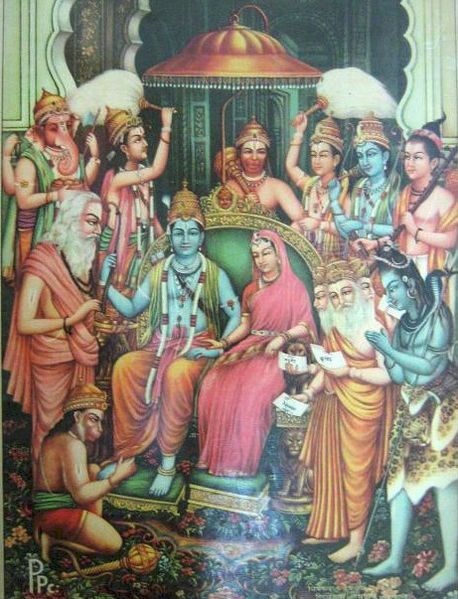
The word Swayamwar literally means a woman choosing her own bridegroom. This custom was prevalent in ancient India where it was a norm for kings to hold Swayamvars for their daughters. During these Swayamvars, eligible suitors from nearby and faraway lands would arrive. Then the princess would choose her bridegoom at her own discretion. Or else, a formidable task would be given to the suitors and whoever fulfilled that task successfully, would get to marry the princess.
It was on those lines that Devi Sita’s swayamvar was also held. The condition was that any man who could lift and string the bow of lord Shiva would have Devi Sita’s hand in marriage. Legend has it that king Janak was given a huge bow as a gift from lord Shiva. When Sita was a child, Parshurama ( an avatar of lord Vishnu ) saw her playing with the gigantic bow and thus advised her father Janak to marry his daughter only to a man who could lift that bow.
When the time for the swayamwar came, only Prabhu Shri Ram out of all suitors could lift and string it. So this is how Lord Ram and Devi Sita got married.
Devi Sita Exile to Forest and Abduction by Ravana
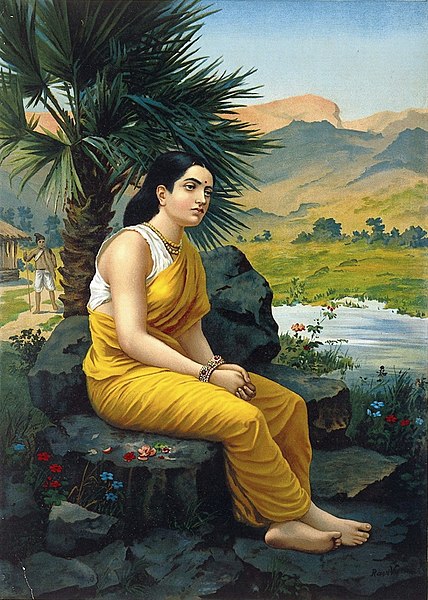
After her marriage with lord Ram, Sita Mata moved to Ayodhya. But soon, queen Kaikeyi, the youngest queen of king Dashrath, the father of lord Ram, took a promise from him that he would send his eldest son Ram to 14 years of exile in the forest and hand over the reins of the kingdom of Ayodhya to her son Bharat. Being a man of honor, Dashrath had no option but to fulfill the promise. Thus, Devi Sita also decided to accompany her husband to a 14 year forest exile. Thus, Lord Rama, Devi Sita, and Lakshman, the younger brother of lord Ram proceeded to the forest.

One day in the forest, Sita Mata took a fancy to a golden deer running by, and she asked lord Ram to catch him. However, lord Ram didn’t return for a long time and Devi Sita got worried. Thus, she decided to send Lakshman to look for Ram. But Lakshman was worried about her safety and couldn’t leave her alone in the hut unprotected. He thus drew a protective circle around the hut and asked Mata Sita not to venture outside its limits.
Ravana abducts Sita
Now, Ravana, the king of Lanka disguised as a Brahmin approached Mata Sita asking her for alms. Sita was in a dilemma since Lakshman had asked her not to cross the circle. But she ultimately fell into Ravana’s cunning trap and crossed the boundary. Thus, Ravana abducted her and took her to his kingdom in Lanka where she would be held captive for a long time to come.
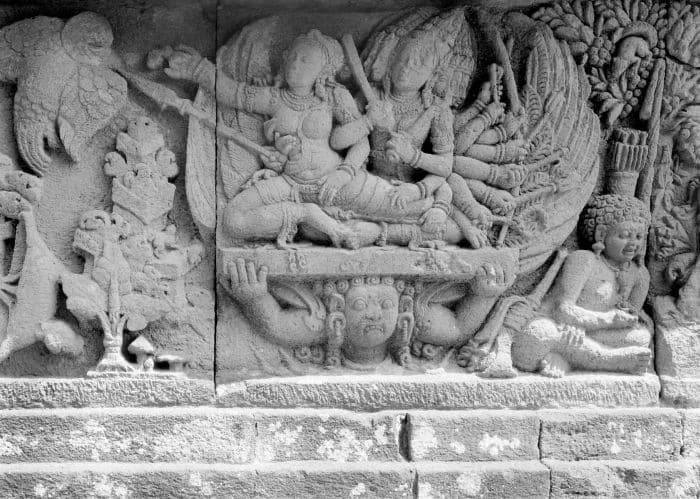
Sita Mata Agni Pariksha
Lord Ram finally freed Mata Sita after a fierce battle with Ravana and his army. The amazing thing is lord Ram followed the principles of exile and didn’t call his army from Ayodhya for the battle. Instead, he improvised through whatever nature gave him and fought the battle along with a vaanar sena ( an army of monkeys).
However, as per the societal norms of that time, Devi Sita was required to prove her innocence. She would do so by giving an Agni Pariksha, that is walking through the fire. Legend has it that she coolly walked through the fire, her purity and innocence protecting her from burning. Instead, the coal pieces became lotus blossoms.
Thus, Mata Sita accompanied lord Ram along with Lakshman to the kingdom of Ayodhya after completing their 14 year period of forest exile.
Sita Mata Second Exile
Once lord Ram returned to Ayodhya along with Mata Sita, the praja ( the residents of Ayodhya) started gossiping about Mata Sita spending a long time in the kingdom of another man ( Ravana). It is hard to explain the mindset of common people of that time in today’s modern world but such was the moral code of those times. The king being a king, had to listen to his subjects and act in accordance with their wishes, even if he didn’t agree with their viewpoint.
Thus, lord Ram was forced to heed the words of the local residents of Ayodhya and thus Devi Sita had to leave the palace and go for yet another exile on account of spending months in Ravana’s Lanka.
Devi Sita being a woman of immense self-respect and courage, chose to live in the forest again. She took refuge in Rishi ( Saint ) Valmiki’s ashram ( hermitage) where she gave birth to two twins Luv and Kusha. She raised her sons all by herself in the middle of the forest and gave them a strong moral upbringing. As time passed, Luv and kush grew up to be bright and vigilant.
When time came for Luv and Kush to get united with their father lord Ram and return to Ayodhya, Sita Mata made a difficult choice. She sent her sons but refused to return to Ayodhya herself. Being a woman of strong values and character, she could not come to terms with the treatment meted out to her by lord Ram for whatever reasons, thus she chose to return to Mother Earth.
Legend has it that Mother Earth split open dramatically and took Mata Sita in its fold again. Thus, this was the end of the mortal existence of Devi Sita.
Sita Mata in Spiritual and Cultural Context
The myths surrounding Sita Mata are imbued with deep spiritual significance. Offering insights into the ideals of Dharma (righteous duty) and personal resilience. Her life story, particularly her unwavering devotion to Lord Rama and her trials, symbolizes the soul’s journey through the challenges of the material world. Sita’s experiences serve as allegories for the spiritual seeker. Illustrating the virtues of patience, fidelity, and moral integrity in the pursuit of spiritual and ethical living.
In the context of women, Sita Mata’s life-trajectory has valuable life-lessons. Both in terms of balancing duty with self-respect as well as independence and individuality. As Sita Mata lives amidst the nurturing forces of nature and raises her children by herself, one can see that she has an independent spirit and is bound by the shackles of society, only as long as she wishes to. She doesn’t think twice before sacrificing a life of worldly happiness and riches at the palace and merges into the earth. Thus ending her worldly existence once she thinks that she has fulfilled her duties.
Sita Mata continues to influence and inspire modern-day Hindus even as we adapt to modernity. Her figure inspires us to stay grounded to our roots, no matter how much we embrace modernity. As a manifestation of Bhoomi Devi or earth-Goddess, Sita Mata also teaches us to appreciate our organic link with nature. As long as we stay humble and true to the core of our existence, we will be happy and blessed. But the moment we become egoistic, greedy and sever ourselves from our very roots, trouble will begin to creep in.
Devotion and Worship of Sita Mata
The worship of Sita Mata is characterized by rituals and practices that honor her life and virtues. During Ram Navami, the birthday of Lord Rama, and Diwali, the festival commemorating his return to Ayodhya, Devi Sita is worshipped alongside lord Ram, highlighting her integral role in the divine narrative. Devotees often recite verses from the Ramayana, perform puja (ritual worship), and offer prayers. Together seeking her blessings for familial harmony and spiritual strength.
Festivals and Celebrations of Sita Mata
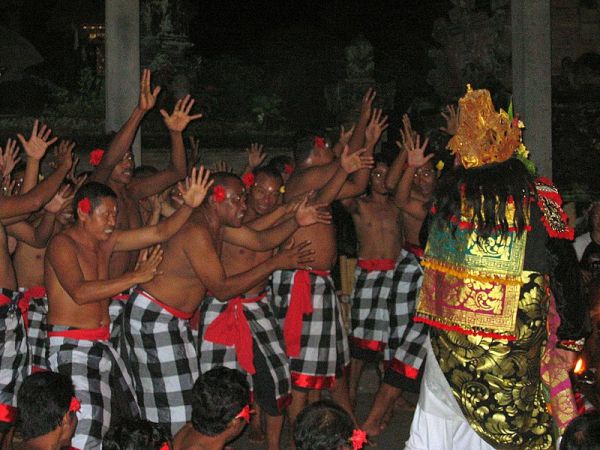
Sita Mata is celebrated and revered through various festivals across India, each highlighting different aspects of her life and virtues.
Vivaha Panchami
This festival commemorates the wedding of Devi Sita and Prabhu Shri Rama. It is observed on the fifth day of Shukl Paksha ( the waxing phase of moon, Hindu calendar month of Agrahayana December-January). Celebrated with great enthusiasm, especially in Janakpur, it involves elaborate rituals and processions reenacting their marriage. In India, grand celebrations take place in temples all over the country, especially in Mithila that is associated with Devi Sita’s birth and Ayodhya that is the birthplace of lord Ram. Besides temple, people also worship lord Ram and Mata Sita at home on this day.
Devotees perform special puja ceremonies at theri home temple and see blessings from Mata Sita and Prabhu Shri Ram. An interesting story associated with Vivaha Panchami is that even though Mata Sita and lord Ram got married on this day, according to Hindu beliefs, it is not considered auspicious to get married on thai day. That is because Mata Sita and lord Ram went through a lot fo trials ansd tribulations as a worldly couple.
Sita Navami
Also known as Janaki Navami, this festival marks the birth of Devi Sita. It falls on the tithi of Navami ( ninth day ) during Shukl Paksha ( white bright lunar fortnight) in the Hindu month of Vaishakh. On this day, women observe fasts and perform special pujas, celebrating Sita’s virtues and her role in the Ramayana. Female devotees pray for the long life of their husbands and perform special pooja of Sita Mata following specific rituals.
This festival is specially celebrated with great enthusiasm in Sita Samahit Sthal in Bihar, Ayodhya ( the birthplace of lord Ram), Rameshwaram in Tamil Nadu and Bhadrachalam in Andhra Pradesh. Devotees often place symbols of a plough and Goddess Earth in front of the idols of Lord Ram, Devi Sita, King Janak and Mata Sunayana ( wife of king Janak) to celebrate the birth of Devi Sita. The puja ceremony is performed using sesame seeds, rice, and barley as offerings.
Devi Sita as a Spiritual Guide
In the realm of spiritual guidance, Sita Mata is revered as a symbol of moral and spiritual strength. Her life’s journey, marked by trials and tribulations, serves as a guiding light for devotees seeking to navigate the complexities of life while adhering to the path of righteousness. She embodies the virtues of endurance and faith, inspiring devotees to uphold their principles in the face of adversity.
Sita Mata’s Manifestations and Forms
Sita Mata, in her divine manifestations, represents various facets of virtue, devotion, and resilience. These aspects highlight her multifaceted nature and the profound symbolism she embodies:
- Sita the Devoted Wife: This aspect emphasizes her unwavering loyalty and love for Rama, symbolizing the ideal of marital devotion.
- Sita the Embodiment of Purity: Her purity, epitomized in the Agni Pariksha, represents her moral and spiritual integrity.
- Sita the Sufferer: This manifestation reflects her endurance and strength in the face of suffering. Symbolizing the human capacity to withstand life’s challenges with grace.
- Sita the Compassionate Mother: Often depicted with her sons Lava and Kusha, this aspect highlights her nurturing and maternal qualities.
Devi Sita in Various Cultural Depictions
Across different cultural contexts, Devi Sita’s portrayals vary, reflecting the diverse interpretations of her character. In classical literature and art, she is often depicted as the epitome of grace and virtue. However, folk traditions present her as a more relatable, humanized figure. These depictions underscore her universal appeal, transcending regional and cultural boundaries. Resonating with the core themes of devotion and moral integrity.
The ancient Hindu epic of Ramayana is popular not just in India but is also well known in countries like Thailand, Laos, and Cambodia to countries like Guyana in South America and Mauritius in Africa. Thus, Mata Sita is worshipped in different countries across the world, apart from India. Mata Sita is one of the prime Hindu deities in Nepal as Janakpuri in Nepal is regarded as her birthplace. There is even a temple dedicated to her in Janakpur.
Ramayana has multiple versions in different countries of the world. One sees a range of fluid interpretations of the Hindu epic and corresponding celebrations. Outside India, the most famous celebrations of Ramayana take place in countries like Myanmar, Thailand, Cambodia, and Indonesia. Devi Sita is a central figure in all the global adaptations of Ramayana. Thus, cultural performances across the world including folk music, theater, etc. continue to be influenced by the multi-faceted persona of Mata Sita.
Temples and Sacred Sites Dedicated to Sita Mata
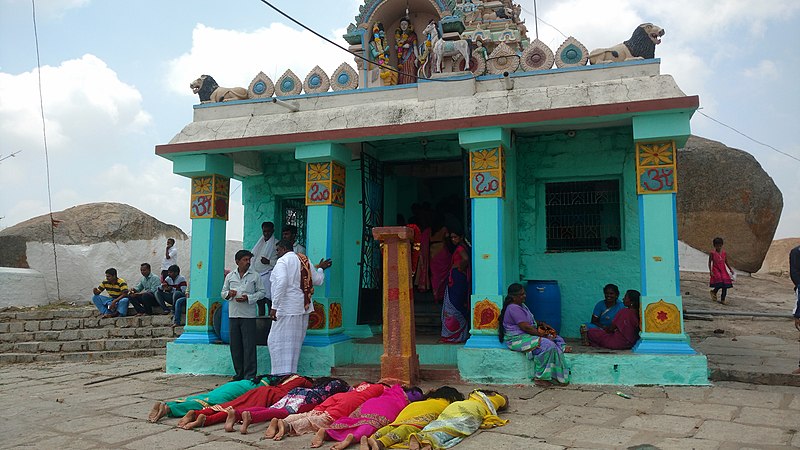
The devotion to Sita Mata is centered around several key pilgrimage sites, each rich in history and spiritual significance. These sacred places are not only destinations for worship but also serve as cultural and spiritual hubs where the essence of Sita’s divine virtues is celebrated.
Janakpur
Located in present-day Nepal, Janakpur is believed to be the birthplace of Mata Sita and the site of her marriage to Lord Rama. The Janaki Temple here is a major pilgrimage destination, revered for its historical and spiritual value.
Chitrakoot
In Chitrakoot, where Sita, Rama, and Lakshmana spent a significant part of their exile, numerous temples and sites like Sphatik Shila are dedicated to their memory. These places are deeply revered by devotees for their association with Mata Sita’s life.
Sitamarhi
The two-storeyed temple dedicated to Devi Sita is surrounded by water during the rainy season. Legend has it that Devi Sita got absorbed into the earth from here. Located in the Bhadohi district of Uttar Pradesh, the temple is known as Sita Samahit Sthal. The temple is also surrounded by a quaint pond that gives the place a distinct aura and draws many tourists.
Ashoknagar
There is yet another famous Sita Mata temple in Karila village in the Indian state of Madhya Pradesh. It is said that this is the only temple of Mata Sita where only her idol sits. That is, it’s considered the only temple in India where Mata Sita is worshipped without lord Ram. As per local beliefs, Mata Sita and lord Ram’s sons Luv and Kush were born at this site. Following local traditions, there is an annual fair at this temple. It falls on the occasion of “Rangpanchami”(the birth anniversary of Mata Sita’s sons Luv and Kush). It is believed that on the pious occasion of the birth of Luv and Kush, even apsaras ( divine dancers from heaven ) had descended on earth and danced to celebrate the occasion.
Seetha Devi Temple Kerala
There is a temple dedicated to Sita Mata in Wayanand, in the southern Indian state of Kerala as well. The temple situated in a serene atmosphere near the banks of the Ponkuzhi river has a structure that follows the traditional Kerala style of architecture with tiled roof. The temple has an idol of Sita Mata and one can also see Luv and Kush’s idols here. It was constructed in the 18th century by Sri Pazhassi Raja. January-February is considered the best time to visit this temple since a festival also takes place there during this time.
Architectural and Artistic Representations
The architecture of temples dedicated to Sita Mata often reflects themes from the Ramayana, with intricate carvings and depictions of her life’s events. These structures are not just places of worship but also artistic representations of mata Sita’s journey, offering devotees a visual narrative of her virtues and trials. The art and architecture in these temples serve as a testament to Sita’s enduring legacy in Hindu culture and spirituality.
Rituals and Customs in Sita’s Festivals
These festivals involve a range of rituals and customs, including storytelling, theatrical reenactments of scenes from the Ramayana, singing devotional songs, and community gatherings. The celebrations are marked by a spirit of devotion and reverence for Sita, with temples and homes decorated to honor her. These festivals not only celebrate Sita’s life but also serve as occasions for communal harmony and spiritual reflection.
Symbols and Icons of Goddess Sita Mata
Sita Mata is often associated with symbols and icons that reflect her virtues and story.
The color saffron, representing purity and renunciation, is frequently associated with her.
The lotus flower, symbolizing beauty and purity amidst adversity, is another common symbol linked to Sita.
Plants, Animals, and Other Elements Linked to Sita Mata
Certain plants and elements hold special significance in Devi Sita’s worship. The Tulsi plant, considered sacred in Hinduism, is often associated with Sita and Rama’s divine union.
The earth element, representing Mata Sita’s return to her mother, Bhumi, at the end of her earthly journey, is also a powerful symbol of her story.
Reflection and Closing Thoughts
Sita Mata’s life, as depicted in the Ramayana, teaches invaluable lessons about virtue, resilience, and the power of faith. Her unwavering commitment to Dharma, despite the trials she faced, serves as a guiding light for moral and spiritual conduct. Her story inspires devotees to uphold righteousness and maintain integrity in the face of challenges.
In Hinduism, it’s a tradition in many households for mothers to narrate stories of inspiring female characters from Hindu epics. Retelling them to their daughters during various festive occasions. Many of these stories would be about various Hindu Goddesses. I remember my mother telling me of Mata Sita’s stories from the Ramayana, when I was a child. She would often tell stories of Mata Sita’s purity, devotion, and determination as I would listen spellbound. Such is the strong influence of Sita Mata in the life and imagination of Hindus.
Devi Sita continues to inspire her devotees throughout the world. Like I mentioned before, her identity is not limited to her corporal form. She incarnated as Sita Mata, the spouse of lord Ram in Treta Yug to fulfill certain roles. But she has an infinite existence that encompasses the universe. Sita Mata ties us to our very roots of existence and reminds us of the ephemeral nature of human life.
Embracing the Virtues of Sita Mata
In contemplating Sita Mata’s role, we are invited to explore the depths of devotion, sacrifice, and moral strength. Her journey is a reminder of the enduring power of faith and virtue. Moreover, encouraging devotees to seek a deeper, more meaningful connection with the divine. Understanding Sita’s role enhances our comprehension of righteousness and spiritual resilience. Guiding us on our own paths of spiritual and ethical living.
Devi Sita Q&A
Devi Sita is the incarnation of Goddess Laksmi.
Devi Sita was born out of a furrow. Thus, it was literally Mother Earth who gave birth to her.
The worldly parents of Sita Mata were King Janak and his wife Sunayana. King Janak discovered her as a newborn baby in the furrow as he was ploughing and decided to adopt her. Bhumi Devi or Earth-Goddess is regarded as the spiritual mother of Devi Sita
Devi Sita was abducted by Lanka king Ravana who disguised himself as a Brahmin begging for alms. He tricked her into crossing the protective circle drawn by lord Ram’s brother Lakshman to protect her.
Sita Mata gave birth to twins – Luv and Kush during her second forest exile at sage Valmiki’s ashram ( hermitage).
It is believed that Sita Mata merged herself into the earth at the site where the famous Sitamarhi temple is . It is located in the Bhadohi district of the Indian state of Uttar Pradesh.
Gallery
- Sita in the hermitage of Valmiki
- Rama seated with Sita, fanned by Lakshmana, while Hanuman pays his respects
- Ravana cuts off Jatayu’s wing while abducting Sita
- Idols of Sita (far right), Rama (center), Lakshmana (far left) and Hanuman (below, seated) at Bhaktivedanta Manor, Watford, England
- Sita being captured by Ravana from her hermitage in the forest.
- Jatayu Attacks Ravana to Save Sita and Shatters his Chariot
- Adhyatma Ramayan Gita Press Gorakhpur
- Marriage of Rama to Sita with Brahmins making fire sacrifice. Coloured transfer lithograph.
- Goddess sita in isckon temple , juhu Mumbai
- Ravana approaches Sita during her captivity.
- Sita kidnap by Ravana
- Sita Haran or the abduction of Sita
- Kalighat Sita & Lava
- Rama Sita Playing
Featured Image Credit: Raja Ravi Varma, Public domain, via Wikimedia Commons


